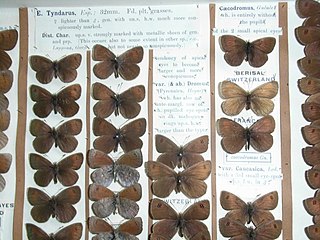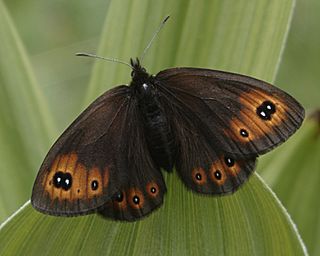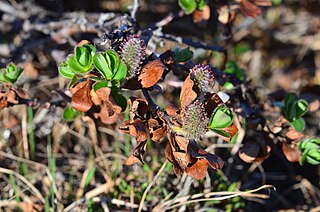
Coenonympha tullia, the large heath or common ringlet, is a butterfly in the family Nymphalidae. It flies in a variety of grassy habitats, including roadsides, woodland edges and clearings, prairies, bogs, and arctic and alpine taiga and tundra. It is a poor flyer, but can sometimes be found along ditches seeking new grounds. It is a holarctic species found in northern Europe, east across the Palearctic and across North America. The species was first described by Otto Friedrich Müller in 1764.

Colias is a genus of butterflies in the family Pieridae. They are often called clouded yellows in the Palearctic and sulphurs in North America. The closest living relative is the genus Zerene, which is sometimes included in Colias.

Erebia is a Holarctic genus of brush-footed butterflies, family Nymphalidae. Most of the about 90–100 species are dark brown or black in color, with reddish-brown to orange or more rarely yellowish wing blotches or bands. These usually bear black spots within, which sometimes have white center spots.

Erebia euryale, the large ringlet, is a species of butterfly belonging to the family Nymphalidae.

The brassy ringlets are a species group of ringlet butterflies in the genus Erebia. Though closely related, their monophyly is not completely resolved. Still, the brassy ringlets are taxa similar to E. tyndarus – the Swiss brassy ringlet –, and in many cases certainly close relatives. A notable trait of their genus is an ability to adapt well to cold and somewhat arid habitat, like taiga or regions with alpine climate. Optimal habitat in Eurasia, where most of the brassy ringlets are found, therefore occurs in two distinct belts – in the very north of the continent and in the Alpide belt – in interglacials, and in glacials in one periglacialic belt at lower altitude, in places interrupted by dry wasteland and deserts.

Colias nastes, the Labrador sulphur, is a butterfly in the family Pieridae. In Europe, it is found in the north of Norway and Sweden and on rare occasions in northern Finland. It is also found in North America, specifically in Alaska, Canada, and the Rocky Mountains, Washington, Montana and on Greenland. In Asia, it is found in the Altai Mountains, the border regions of Russia, China, Mongolia, Kazakhstan, the Sayan Mountains, the north of Siberia, and in the Chukotka Autonomous Okrug.

Colias hecla, the northern clouded yellow or hecla sulphur, is a butterfly in the family Pieridae. In Europe, it is found in the northern part of Norway, Sweden and Finland up to heights of 900 m. It is also found in Greenland, Alaska, the Northwest Territories, Yukon, Quebec, Labrador, Manitoba, the Chukot region, eastern Chukotka, and the Russian Far East.

Erebia epipsodea, the common alpine, is a butterfly species of the subfamily Satyrinae of family Nymphalidae. It is found in North America from Alaska south through the Rocky Mountains to northern New Mexico and east across the prairie provinces to southwest Manitoba.

Salix pulchra is a species of flowering plant in the willow family, known by the common names diamondleaf willow, tealeaf willow, and thin red willow. It is native to northern North America, where it occurs in Alaska, Yukon, the Northwest Territories, and Nunavut. The species is also found in northern British Columbia, and occurs in Russia.

Oeneis bore, the white-veined Arctic or Arctic grayling, is a butterfly, a species of Satyrinae that occurs in North America and Asia.
Erebia lafontainei, the reddish alpine or Lafontaine's alpine, is a member of the subfamily Satyrinae of the family Nymphalidae. It is found in northern North America from Alaska, Yukon, and western Northwest Territories as far east as Tuktoyuktuk.
The four-dotted alpine is a member of the subfamily Satyrinae of the family Nymphalidae. It is found in the north of North America from Alaska, western Yukon, and east in the Northwest Territories as far as Fort McPherson and Tuktoyuktuk.
Erebia anyuica, the scree alpine, is a member of the subfamily Satyrinae of family Nymphalidae. It is found in Siberia, in several isolated areas of Alaska, and in a band that extends across northern Alaska and northern Yukon to the Richardson Mountains on the Yukon/Northwest Territories border.

Erebia discoidalis, the red-disked alpine, is a member of the subfamily Satyrinae of family Nymphalidae. It is found in North America from eastern Quebec, through northern Ontario, and the northern Prairies to northern British Columbia, the Northwest Territories, Yukon, and Alaska. It reaches just into the northern U.S. between Michigan and Montana, and also occurs in Asia, where it has been recorded from the Chukot Peninsula to the eastern Sayan Mountains and Amur. The habitat consists of large, open, grassy bogs and other areas with acidic soils.

Erebia fasciata, the banded alpine, is a member of the subfamily Satyrinae of family Nymphalidae. It is found from central Siberia, through Alaska, Yukon, and mainland Northwest Territories and Nunavut to Hudson Bay. It also occurs on Banks Island and Victoria Island.
Erebia mackinleyensis, the Mt. McKinley alpine, is a butterfly in the subfamily Satyrinae of the family Nymphalidae. It is found from eastern Siberia through Alaska and Yukon, just reaching into the Northwest Territories in the Richardson Mountains and into British Columbia at Stone Mountain Provincial Park.
The Magdalena alpine is a member of the subfamily Satyrinae of the family Nymphalidae. It is found in North America from Montana, Colorado, Utah, and New Mexico, and in Canada in a small part of the Willmore Wilderness Park, Alberta, and adjacent British Columbia, in Stone Mountain Provincial Park in northern British Columbia, and on an isolated nunatak in Kluane National Park and Reserve, Yukon. The habitat consists of rockslides near vegetation, at or above the treeline.
Erebia mancinus, the taiga alpine, is a member of the subfamily Satyrinae of the family Nymphalidae. It lives in subarctic North America from Labrador, northern Quebec, and northern Ontario, through the northern Prairie Provinces, northern British Columbia, and the interior of the Northwest Territories to Yukon and Alaska. It also ranges south in the mountains as far as Banff, Alberta. The habitat consists of black spruce-sphagnum bogs.
Gynaephora rossii, in English known as Ross' tussock moth, is a species of tussock moth in the family Erebidae. It is widespread in the tundras and highlands of the Holarctic. It has large, furry caterpillars which seem to eat mostly saxifrages.











